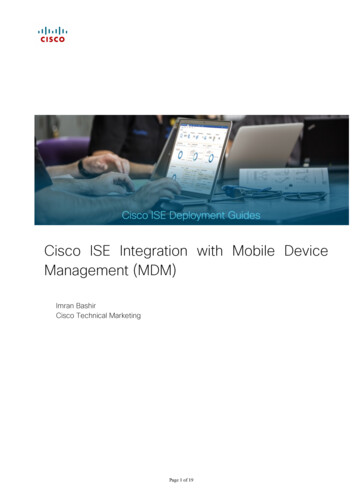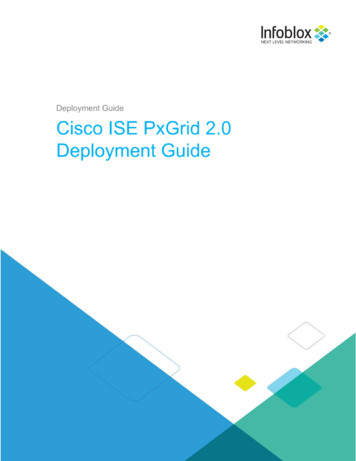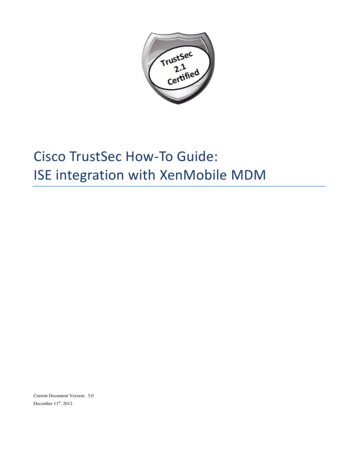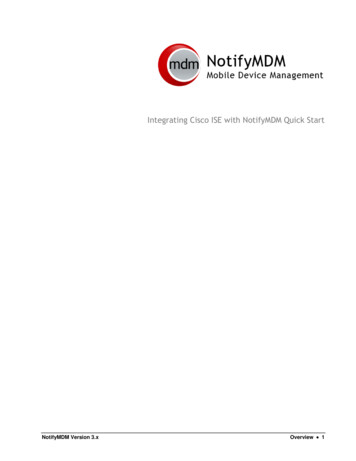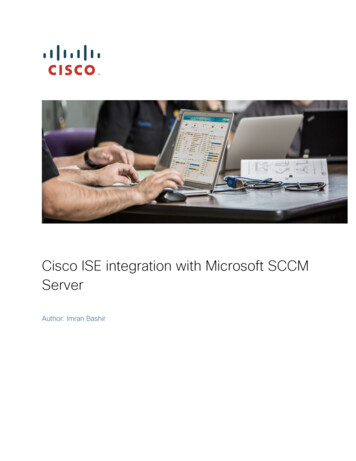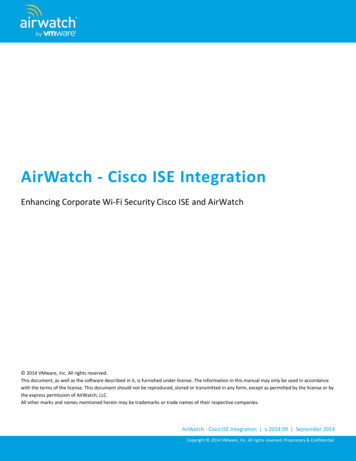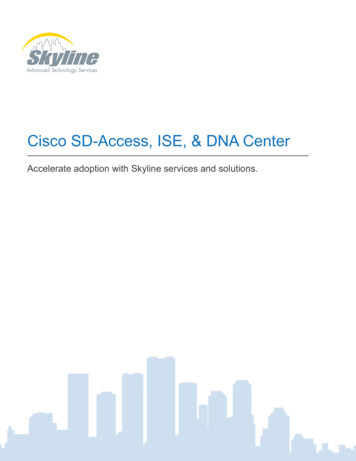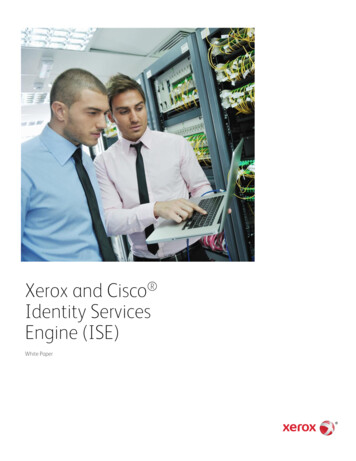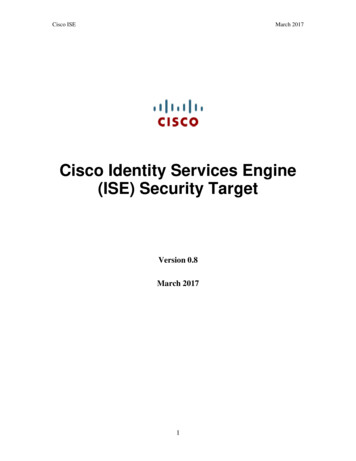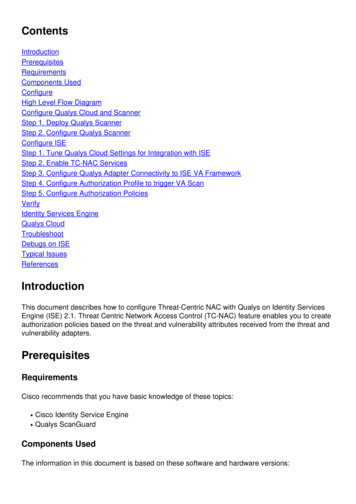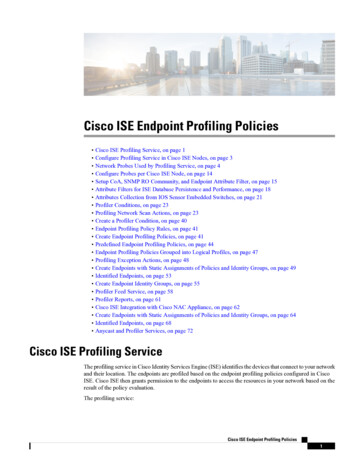
Transcription
Cisco ISE Endpoint Profiling Policies Cisco ISE Profiling Service, on page 1 Configure Profiling Service in Cisco ISE Nodes, on page 3 Network Probes Used by Profiling Service, on page 4 Configure Probes per Cisco ISE Node, on page 14 Setup CoA, SNMP RO Community, and Endpoint Attribute Filter, on page 15 Attribute Filters for ISE Database Persistence and Performance, on page 18 Attributes Collection from IOS Sensor Embedded Switches, on page 21 Profiler Conditions, on page 23 Profiling Network Scan Actions, on page 23 Create a Profiler Condition, on page 40 Endpoint Profiling Policy Rules, on page 41 Create Endpoint Profiling Policies, on page 41 Predefined Endpoint Profiling Policies, on page 44 Endpoint Profiling Policies Grouped into Logical Profiles, on page 47 Profiling Exception Actions, on page 48 Create Endpoints with Static Assignments of Policies and Identity Groups, on page 49 Identified Endpoints, on page 53 Create Endpoint Identity Groups, on page 55 Profiler Feed Service, on page 58 Profiler Reports, on page 61 Cisco ISE Integration with Cisco NAC Appliance, on page 62 Create Endpoints with Static Assignments of Policies and Identity Groups, on page 64 Identified Endpoints, on page 68 Anycast and Profiler Services, on page 72Cisco ISE Profiling ServiceThe profiling service in Cisco Identity Services Engine (ISE) identifies the devices that connect to your networkand their location. The endpoints are profiled based on the endpoint profiling policies configured in CiscoISE. Cisco ISE then grants permission to the endpoints to access the resources in your network based on theresult of the policy evaluation.The profiling service:Cisco ISE Endpoint Profiling Policies1
Cisco ISE Endpoint Profiling PoliciesProfiler Work Center Facilitates an efficient and effective deployment and ongoing management of authentication by usingIEEE standard 802.1X port-based authentication access control, MAC Authentication Bypass (MAB)authentication, and Network Admission Control (NAC) for any enterprise network of varying scale andcomplexity. Identifies, locates, and determines the capabilities of all of the attached network endpoints regardless ofendpoint types. Protects against inadvertently denying access to some endpoints.Profiler Work CenterThe Profiler Work Center menu (Work Centers Profiler) contains all the profiler pages, which acts as asingle start point for ISE administrators. The Profiler Work Center menu contains the following options:Overview, Ext ID Stores, Network Devices, Endpoint Classification, Node Config, Feeds, Manual Scans,Policy Elements, Profiling Policies, Authorization Policy, Troubleshoot, Reports, Settings, and Dictionaries.Profiler DashboardThe Profiler dashboard (Work Centers Profiler Endpoint Classification) is a centralized monitoring toolfor the profiles, endpoints, and assets in your network. The dashboard represents data in both graphical andtable formats. The Profiles dashlet displays the logical and endpoint profiles that are currently active in thenetwork. The Endpoints dashlet displays the identity group, PSNs, OS types of the endpoints that connect toyour network. The Assets dashlet displays flows such as Guest, BYOD, and Corporate. The table displaysthe various endpoints that are connected and you can also add new endpoints.Endpoint Inventory Using Profiling ServiceYou can use the profiling service to discover, locate, and determine the capabilities of all the endpointsconnected to your network. You can ensure and maintain appropriate access of endpoints to the enterprisenetwork, regardless of their device types.The profiling service collects attributes of endpoints from the network devices and the network, classifiesendpoints into a specific group according to their profiles, and stores endpoints with their matched profilesin the Cisco ISE database. All the attributes that are handled by the profiling service need to be defined in theprofiler dictionaries.The profiling service identifies each endpoint on your network, and groups those endpoints according to theirprofiles to an existing endpoint identity group in the system, or to a new group that you can create in thesystem. By grouping endpoints, and applying endpoint profiling policies to the endpoint identity group, youcan determine the mapping of endpoints to the corresponding endpoint profiling policies.Cisco ISE Profiler Queue Limit ConfigurationCisco ISE profiler collects a significant amount of endpoint data from the network in a short period of time.It causes Java Virtual Machine (JVM) memory utilization to go up due to accumulated backlog when someof the slower Cisco ISE components process the data generated by the profiler, which results in performancedegradation and stability issues.To ensure that the profiler does not increase the JVM memory utilization and prevent JVM to go out of memoryand restart, limits are applied to the following internal components of the profiler:Cisco ISE Endpoint Profiling Policies2
Cisco ISE Endpoint Profiling PoliciesMartian IP Addresses Endpoint Cache: Internal cache is limited in size that has to be purged periodically (based on least recentlyused strategy) when the size exceeds the limit. Forwarder: The main ingress queue of endpoint information collected by the profiler. Event Handler: An internal queue that disconnects a fast component, which feeds data to a slowerprocessing component (typically related to a database query).Endpoint Cache maxEndPointsInLocalDb 100000 (endpoint objects in cache) endPointsPurgeIntervalSec 300 (endpoint cache purge thread interval in seconds) numberOfProfilingThreads 8 (number of threads)The limit is applicable to all profiler internal event handlers. A monitoring alarm is triggered when queue sizelimit is reached.Cisco ISE Profiler Queue Size Limits forwarderQueueSize 5000 (endpoint collection events) eventHandlerQueueSize 10000 (events)Event Handlers NetworkDeviceEventHandler: For network device events, in addition to filtering duplicate NetworkAccess Device (NAD) IP addresses, which are already cached. ARPCacheEventHandler: For ARP Cache events.Martian IP AddressesMartian IP addresses are not displayed in Context Visibility Endpoints and Work Centers Profiler Endpoint Classification windows as the RADIUS parser removes such addresses before they reach theprofiling service. Martian IP addresses are a security concern as they are vulnerable to attacks. However,martian IP addresses are displayed in MnT logs for auditing purposes. This behaviour stands true in the caseof multicast IP addresses as well. For more information on Martian IP addresses, seehttps://www.cisco.com/assets/sol/sb/Switches Emulators v2 3 5 xx/help/250/index.html#page/tesla 250 olh/martian addresses.htmlConfigure Profiling Service in Cisco ISE NodesYou can configure the profiling service that provides you a contextual inventory of all the endpoints that areusing your network resources in any Cisco ISE-enabled network.You can configure the profiling service to run on a single Cisco ISE node that assumes all Administration,Monitoring, and Policy Service personas by default.In a distributed deployment, the profiling service runs only on Cisco ISE nodes that assume the Policy Servicepersona and does not run on other Cisco ISE nodes that assume the Administration and Monitoring personas.Cisco ISE Endpoint Profiling Policies3
Cisco ISE Endpoint Profiling PoliciesNetwork Probes Used by Profiling ServiceStep 1Step 2Choose a Cisco ISE node that assumes the Policy Service persona.Step 3Click Edit in the Deployment Nodes page.Step 4On the General Settings tab, check the Policy Service check box. If the Policy Service check box is unchecked, boththe session services and the profiling service check boxes are disabled.Step 5Perform the following tasks:a) Check the Enable Session Services check box to run the Network Access, Posture, Guest, and Client Provisioningsession services.b) Check the Enable Profiling Services check box to run the profiling service.c) Check the Enable Device Admin Service check box to run the device administration service to control and audit anenterprise's network devices.Step 6Click Save to save the node configuration.Network Probes Used by Profiling ServiceNetwork probe is a method used to collect an attribute or a set of attributes from an endpoint on your network.The probe allows you to create or update endpoints with their matched profile in the Cisco ISE database.Cisco ISE can profile devices using a number of network probes that analyze the behavior of devices on thenetwork and determine the type of the device. Network probes help you to gain more network visibility.IP Address and MAC Address BindingYou can create or update endpoints only by using their MAC addresses in an enterprise network. If you donot find an entry in the ARP cache, then you can create or update endpoints by using the L2 MAC address ofan HTTP packet and the IN SRC MAC of a NetFlow packet in Cisco ISE. The profiling service is dependenton L2 adjacency when endpoints are only a hop away. When endpoints are L2 adjacent, the IP addresses andMAC addresses of endpoints are already mapped, and there is no need for IP-MAC cache mapping.If endpoints are not L2 adjacent and are multiple hops away, mapping may not be reliable. Some of the knownattributes of NetFlow packets that you collect include PROTOCOL, L4 SRC PORT, IPV4 SRC ADDR,L4 DST PORT, IPV4 DST ADDR, IN SRC MAC, OUT DST MAC, IN SRC MAC, andOUT SRC MAC. When endpoints are not L2 adjacent and are multiple L3 hops away, the IN SRC MACattributes carry only the MAC addresses of L3 network devices. When the HTTP probe is enabled in CiscoISE, you can create endpoints only by using the MAC addresses of HTTP packets, because the HTTP requestmessages do not carry IP addresses and MAC addresses of endpoints in the payload data.Cisco ISE implements an ARP cache in the profiling service, so that you can reliably map the IP addressesand the MAC addresses of endpoints. For the ARP cache to function, you must enable either the DHCP probeor the RADIUS probe. The DHCP and RADIUS probes carry the IP addresses and the MAC addresses ofendpoints in the payload data. The dhcp-requested address attribute in the DHCP probe and theFramed-IP-address attribute in the RADIUS probe carry the IP addresses of endpoints, along with their MACaddresses, which can be mapped and stored in the ARP cache.Cisco ISE Endpoint Profiling Policies4
Cisco ISE Endpoint Profiling PoliciesNetFlow ProbeNetFlow ProbeCisco ISE profiler implements Cisco IOS NetFlow Version 9. We recommend using NetFlow Version 9,which has additional functionality needed to enhance the profiler to support the Cisco ISE profiling service.You can collect NetFlow Version 9 attributes from the NetFlow-enabled network access devices to create anendpoint, or update an existing endpoint in the Cisco ISE database. You can configure NetFlow Version 9 toattach the source and destination MAC addresses of endpoints and update them. You can also create a dictionaryof NetFlow attributes to support NetFlow-based profiling.For more information on the NetFlow Version 9 Record Format, see Table 6, “NetFlow Version 9 Field TypeDefinitions” of the NetFlow Version 9 Flow-Record Format document.In addition, Cisco ISE supports NetFlow versions earlier than Version 5. If you use NetFlow Version 5 inyour network, then you can use Version 5 only on the primary network access device (NAD) at the accesslayer because it will not work anywhere else.Cisco IOS NetFlow Version 5 packets do not contain MAC addresses of endpoints. The attributes that arecollected from NetFlow Version 5 cannot be directly added to the Cisco ISE database. You can discoverendpoints by using their IP addresses, and append the NetFlow Version 5 attributes to endpoints, which canbe done by combining IP addresses of the network access devices and IP addresses obtained from the NetFlowVersion 5 attributes. However, these endpoints must have been previously discovered with the RADIUS orSNMP probe.The MAC address is not a part of IP flows in earlier versions of NetFlow Version 5, which requires you toprofile endpoints with their IP addresses by correlating the attributes information collected from the networkaccess devices in the endpoints cache.For more information on the NetFlow Version 5 Record Format, see Table 2, “Cisco IOS NetFlow FlowRecord and Export Format Content Information” of the NetFlow Services Solutions Guide.Related TopicsProfiling Node SettingsDHCP ProbeThe Dynamic Host Configuration Protocol probe in your Cisco ISE deployment allows the Cisco ISE profilingservice to reprofile endpoints based only on new requests of INIT-REBOOT and SELECTING message types.Though other DHCP message types such as RENEWING and REBINDING are processed, they are not usedfor profiling endpoints. Any attribute parsed out of DHCP packets is mapped to endpoint attributes.DHCPREQUEST Message Generated During INIT-REBOOT StateIf the DHCP client checks to verify a previously allocated and cached configuration, then the client must notfill in the Server identifier (server-ip) option. Instead it should fill in the Requested IP address (requested-ip)option with the previously assigned IP address, and fill in the Client IP Address (ciaddr) field with zero in itsDHCPREQUEST message. The DHCP server will then send a DHCPNAK message to the client if theRequested IP address is incorrect or the client is located in the wrong network.DHCPREQUEST Message Generated During SELECTING StateThe DHCP client inserts the IP address of the selected DHCP server in the Server identifier (server-ip) option,fills in the Requested IP address (requested-ip) option with the value of the Your IP Address (yiaddr) fieldfrom the chosen DHCPOFFER by the client, and fills in the “ciaddr” field with zero.Cisco ISE Endpoint Profiling Policies5
Cisco ISE Endpoint Profiling PoliciesWireless LAN Controller Configuration in DHCP Bridging ModeTable 1: DHCP Client Messages from Different ver-ipMUST NOTMUSTMUST NOTMUST NOTrequested-ipMUSTMUSTMUST NOTMUST NOTciaddrzerozeroIP addressIP addressRelated TopicsProfiling Node SettingsWireless LAN Controller Configuration in DHCP Bridging ModeWe recommend that you configure wireless LAN controllers (WLCs) in Dynamic Host Configuration Protocol(DHCP) bridging mode, where you can forward all the DHCP packets from the wireless clients to Cisco ISE.You must uncheck the Enable DHCP Proxy check box available in the WLC web interface: Controller Advanced DHCP Master Controller Mode DHCP Parameters. You must also ensure that the DHCPIP helper command points to the Cisco ISE Policy Service node.DHCP SPAN ProbeThe DHCP Switched Port Analyzer (SPAN) probe, when initialized in a Cisco ISE node, listens to networktraffic, which are coming from network access devices on a specific interface. You need to configure networkaccess devices to forward DHCP SPAN packets to the Cisco ISE profiler from the DHCP servers. The profilerreceives these DHCP SPAN packets and parses them to capture the attributes of an endpoint, which can beused for profiling endpoints.For example,switch(config)# monitor session 1 source interface Gi1/0/4switch(config)# monitor session 1 destination interface Gi1/0/2Related TopicsProfiling Node SettingsHTTP ProbeIn HTTP probe, the identification string is transmitted in an HTTP request-header field User-Agent, whichis an attribute that can be used to create a profiling condition of IP type, and to check the web browserinformation. The profiler captures the web browser information from the User-Agent attribute along withother HTTP attributes from the request messages, and adds them to the list of endpoint attributes.Cisco ISE listens to communication from the web browsers on both port 80 and port 8080. Cisco ISE providesmany default profiles, which are built in to the system to identify endpoints based on the User-Agent attribute.HTTP probe is enabled by default. Multiple ISE services such as CWA, Hotspot, BYOD, MDM, and Posturerely on URL-redirection of the client's web browser. The redirected traffic includes the RADIUS session IDof the connected endpoint. When a PSN terminates these URL-redirected flows, it has visibility into thedecrypted HTTPS data. Even when the HTTP probe is disabled on the PSN, the node will parse the browserCisco ISE Endpoint Profiling Policies6
Cisco ISE Endpoint Profiling PoliciesHTTP SPAN Probeuser agent string from the web traffic and correlate the data to the endpoint based on its associated sessionID. When browser strings are collected through this method, the source of the data is listed as Guest Portalor CP (Client Provisioning) rather than HTTP Probe.Related TopicsProfiling Node SettingsHTTP SPAN ProbeThe HTTP probe in your Cisco ISE deployment, when enabled with the Switched Port Analyzer (SPAN)probe, allows the profiler to capture HTTP packets from the specified interfaces. You can use the SPANcapability on port 80, where the Cisco ISE server listens to communication from the web browsers.HTTP SPAN collects HTTP attributes of an HTTP request-header message along with the IP addresses in theIP header (L3 header), which can be associated to an endpoint based on the MAC address of an endpoint inthe L2 header. This information is useful for identifying different mobile and portable IP-enabled devicessuch as Apple devices, and computers with different operating systems. Identifying different mobile andportable IP-enabled devices is made more reliable because the Cisco ISE server redirects captures during aguest login or client provisioning download. This allows the profiler to collect the User-Agent attribute andother HTTP attributes, from the request messages and then identify devices such as Apple devices.Unable to Collect HTTP Attributes in Cisco ISE Running on VMwareIf you deploy Cisco ISE on an ESX server (VMware), the Cisco ISE profiler collects the Dynamic HostConfiguration Protocol traffic but does not collect the HTTP traffic due to configuration issues on the vSphereclient. To collect HTTP traffic on a VMware setup, configure the security settings by changing the PromiscuousMode to Accept from Reject (by default) of the virtual switch that you create for the Cisco ISE profiler. Whenthe Switched Port Analyzer (SPAN) probe for DHCP and HTTP is enabled, Cisco ISE profiler collects boththe DHCP and HTTP traffic.pxGrid ProbeThe pxGrid probe leverages Cisco pxGrid for receiving endpoint context from external sources. Prior to CiscoISE 2.4, Cisco ISE served only as a publisher and shared various context information such as session identityand group information as well as configuration elements to external subscribers. With the introduction of thepxGrid probe in Cisco ISE 2.4, other solutions serve as the publishers and Cisco ISE Policy Service nodesbecome the subscribers.The pxGrid probe is based on pxGrid v2 specification using the Endpoint Asset topic/topic/com.cisco.endpoint.asset with Service Name com.cisco.endpoint.asset. The following table displaysthe topic attributes all of which are preceded by the prefix asset.Table 2: Endpoint Asset TopicAttribute NameType DescriptionassetIdLong Asset IDassetNameString Asset nameassetIpAddressString IP addressassetMacAddressString MAC addressCisco ISE Endpoint Profiling Policies7
Cisco ISE Endpoint Profiling PoliciesRADIUS ProbeassetVendorString ManufacturerassetProductIdString Product CodeassetSerialNumberString Serial NumberassetDeviceTypeString Device TypeassetSwRevisionString S/W Revision numberassetHwRevisionString H/W Revision numberassetProtocolString ProtocolassetConnectedLinks Array Array of Network Link objectsassetCustomAttributes Array Array of Custom name-value pairsIn addition to the attributes commo
Step1 Step2 ona. Step3 ClickEdit intheDeploymentNodespage. S

